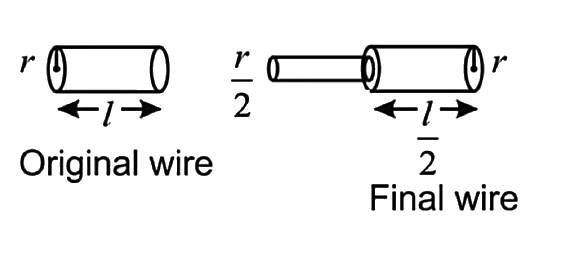A wire of resistance 3 ohm and length 10 cm is stretched to length 30 cm. Assuming that it has a uniform cross section, what will be its new resistance ?
To find the new resistance of the wire after it has been stretched, we can follow these steps:
Step 1: Understand the relationship between resistance, length, and area.
The resistance R of a wire is given by the formula:
R=ρ⋅lA
where:
- R is the resistance,
- ρ is the resistivity of the material,
- l is the length of the wire,
- A is the cross-sectional area of the wire.
Step 2: Identify the initial conditions.
From the question, we know:
- Initial resistance R1=3Ω
- Initial length l1=10cm
Step 3: Determine the new length after stretching.
The wire is stretched to a new length:
l2=30cm
This means the length has increased by a factor of:
l2l1=30cm10cm=3
Step 4: Determine the new cross-sectional area.
When a wire is stretched, its volume remains constant (assuming no material is added or removed). The volume V of the wire can be expressed as:
V=A⋅l
Thus, the initial volume V1 is:
V1=A1⋅l1
And the new volume V2 is:
V2=A2⋅l2
Since V1=V2, we have:
A1⋅l1=A2⋅l2
Substituting the values we know:
A1⋅10=A2⋅30
From this, we can express A2 in terms of A1:
A2=A1⋅1030=A13
Step 5: Calculate the new resistance.
Using the resistance formula for the new conditions:
R2=ρ⋅l2A2
Substituting l2 and A2:
R2=ρ⋅(3⋅l1)A13=3⋅ρ⋅l1⋅3A1=9⋅ρ⋅l1A1
Notice that ρ⋅l1A1=R1:
R2=9⋅R1
Substituting R1=3Ω:
R2=9⋅3=27Ω
Conclusion:
The new resistance of the wire after stretching is:
27Ω
The resistance R of a wire is given by the formula:
R=ρ⋅lA
where:
- R is the resistance,
- ρ is the resistivity of the material,
- l is the length of the wire,
- A is the cross-sectional area of the wire.
From the question, we know:
- Initial resistance R1=3Ω
- Initial length l1=10cm
The wire is stretched to a new length:
l2=30cm
This means the length has increased by a factor of:
l2l1=30cm10cm=3
When a wire is stretched, its volume remains constant (assuming no material is added or removed). The volume V of the wire can be expressed as:
V=A⋅l
Thus, the initial volume V1 is:
V1=A1⋅l1
And the new volume V2 is:
V2=A2⋅l2
Since V1=V2, we have:
A1⋅l1=A2⋅l2
Substituting the values we know:
A1⋅10=A2⋅30
From this, we can express A2 in terms of A1:
A2=A1⋅1030=A13
Using the resistance formula for the new conditions:
R2=ρ⋅l2A2
Substituting l2 and A2:
R2=ρ⋅(3⋅l1)A13=3⋅ρ⋅l1⋅3A1=9⋅ρ⋅l1A1
Notice that ρ⋅l1A1=R1:
R2=9⋅R1
Substituting R1=3Ω:
R2=9⋅3=27Ω
The new resistance of the wire after stretching is:
27Ω
Topper's Solved these Questions
- CURRENT ELECTRICITYBOOK - ICSECHAPTER - CURRENT ELECTRICITYEXERCISE - EXERCISE-8(B)
15 Videos
- CURRENT ELECTRICITYBOOK - ICSECHAPTER - CURRENT ELECTRICITYEXERCISE - EXERCISE-8(B) (MULTIPLE CHOICE TYPE)
3 Videos
- CURRENT ELECTRICITYBOOK - ICSECHAPTER - CURRENT ELECTRICITYEXERCISE - EXERCISE-8(A) ( MULTIPLE CHOICE TYPE)
2 Videos
- CALORIMETRYBOOK - ICSECHAPTER - CALORIMETRYEXERCISE - EXERCISE-11(B) (NUMERICALS)
15 Videos
- ELECTRO-MAGNETISM BOOK - ICSECHAPTER - ELECTRO-MAGNETISM EXERCISE - EXERCISE-10 (C) NUMERICALS
1 Videos
Similar Questions
Knowledge Check
A potentiometer wire of length 100 cm has a resistance of 100Ω it is connected in series with a resistance and a battery of emf 2 V and of negligible internal resistance. A source of emf 10 mV is balanced against a length of 40 cm of the potentiometer wire. what is the value of the external resistance?
A790ΩB890ΩC990ΩD1090Ω
When the length and area of cross-section both are doubled, then its resistance
View SolutionA wire of resistance 4Ω is stretched to twice its original length. In the process of stretching, its area of cross-section gets halved. Now, the resistance of the wire is
View SolutionA given wire of resistance 1 Ω is stretched to double its length. What will be its new resistance ?
View SolutionA wire of resistance 4Ω is stretched to twice its original length. The resistance of stretched wire would be
View SolutionDefine 1 ohm resistance.
A student has a resistance wire of 1 ohm. If the length of this wire is 50 cm, to what
length he should stretch it uniformly so as to obtain a wire of 4Ω resistance? Justify
your answer .
View SolutionA wire of length l has a resistance R. If half of the length is stretched to make the radius half of its original value, then the final resistance of the wire is

View SolutionA wire of resistance(10Ω) is stretched to twice its original length. The resistance of half of the streached wire is
View Solution
